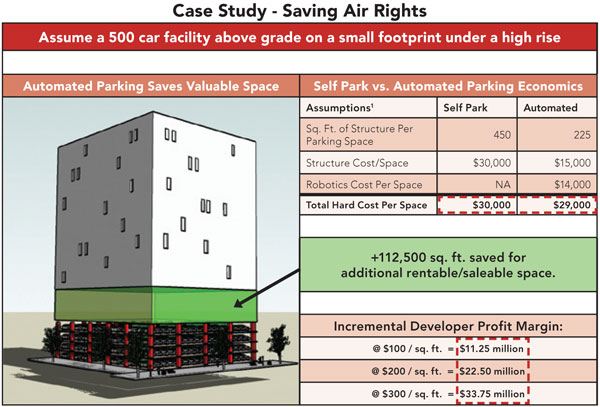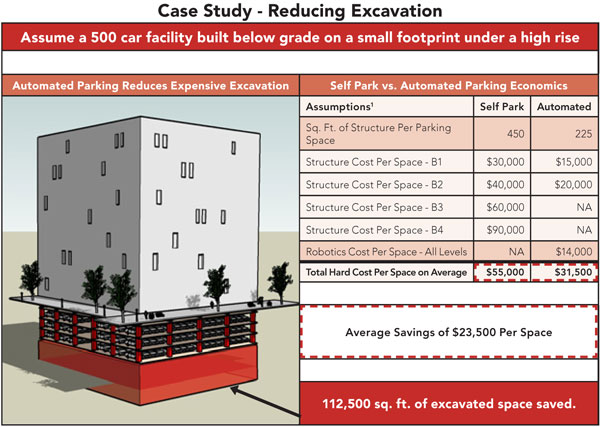Robots Update the Parking Garage
Economic Benefits of Automated Parking Systems
In addition to bringing enhanced security and convenience to parking, the increased efficiency of an automated parking system often contributes to the economics of development projects in any of the following ways:
Unlocking Valuable Air Rights
By using less volume of the building for parking, developers have more cubic footage for higher yielding development. Since automated parking systems occupy less square footage than traditional garages, they consume far less valuable air rights. Consider a hypothetical example of a 500-space residential tower in which a self-park garage and an automated garage would occupy 225,000 square feet and 112,500 square feet, respectively. By using automated parking, the increase in project value realized by the developer would range between $11.25 and $33.75 million depending upon the value of the air rights. See table below for estimates at different market values for air rights.
 |
|
1. Assumptions are for illustrative purposes only. Actual metrics will vary significantly depending on the specific circumstances of each project. Source: Boomerang Systems, Inc. |
Reducing Excavation Costs
While above-grade parking consumes valuable real estate, below-grade parking often carries with it high excavation costs due to rock formations or a high water table. Since an automated parking system requires up to half the space of a conventional garage, and since deeper floors cost more to excavate than shallower floors, the use of an automated parking system logically eliminates the most expensive-to-excavate floors from a basement garage. In the hypothetical example of an urban infill mixed-use structure, a developer could achieve average savings of $23,500 per space, by selecting an automated system. (See table of estimates for different structure costs.)
 |
|
1. Assumptions are for illustrative purposes only. Actual metrics will vary significantly depending on the specific circumstances of each project. Source: Boomerang Systems, Inc. |
Reducing Construction Costs
According to some developers' estimates, the construction cost savings for automated parking can amount to 50 percent. Compared with a conventional self-park garage, an automated parking system requires less concrete per car and the resulting structure requires no ramps, long span construction, passengers lifts, and lift lobbies. Except in the entry/exit area, there is also no need for paint on the walls, curbs, signage, speed bumps, railings, or vehicle barriers throughout the majority of the parking structure.
Lower Insurance Hazard Risks
Insurance underwriters typically assign a low hazard risk for automated parking systems due to the virtual elimination of: physical assault, theft, vandalism, dings, dents, scratches, weather hazards, and collisions. Product liability is also reduced for those automated parking systems using vehicle trays, which prevent oil or salt water dripping from higher racks.









